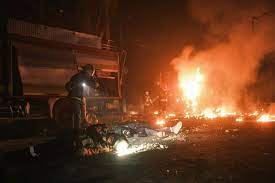Overview of Systematic Targeting of Civilians
Recent investigations have revealed a troubling pattern of systematic targeting of civilians in Ukraine, particularly through coordinated drone attacks and other military operations conducted by Russian authorities. An independent international commission of inquiry on Ukraine has provided a detailed report outlining these actions, which are described as violations of human rights and international humanitarian law.
The report indicates that various regions, particularly along the Dnipro River, have been severely affected by these military assaults. Communities located in these areas have faced not only loss of life but also profound disruptions to their daily existence. This systematic violence appears to be a coordinated strategy aimed at inflicting maximum harm upon the civilian population, thereby creating an atmosphere of fear and instability.
Witness testimonies and documented evidence highlight the indiscriminate nature of the drone strikes. These attacks have predominantly targeted civilian infrastructure, including residential buildings, schools, and hospitals, resulting in significant collateral damage and civilian casualties. The psychological impact on the communities is immense, given the threat of drone warfare looms over daily life, often leaving inhabitants in a state of constant anxiety.
Furthermore, the geographical scope of these attacks has been characterized by disproportionate targeting of areas with higher civilian populations, raising concerns about the intent and legality of such military actions. It underscores a strategic method of warfare that prioritizes the degradation of civilian life to achieve broader military objectives, calling into question the commitment to international norms regarding the protection of non-combatants during conflicts.
This systematic targeting not only highlights grave ethical issues but also requires urgent international attention. The consistent patterns of attacks in regions along the Dnipro River exemplify the ongoing humanitarian crisis in Ukraine and compel the global community to reassess the implications of drone warfare on civilian populations.
Nature and Consequences of Drone Attacks
In recent conflicts, particularly in Ukraine, drone warfare has emerged as a significant tactic utilized by the Russian armed forces. This method leverages advanced technologies to conduct precise strikes on various targets; however, its implementation has frequently led to devastating impacts on civilian populations. The nature of the drone attacks involves unmanned aerial vehicles (UAVs) that can operate at high altitudes, making them less susceptible to traditional countermeasures. Consequently, these drone strikes have resulted in substantial civilian casualties and extensive destruction of infrastructure.
Eyewitness testimonies from individuals residing in frontline areas illustrate the harrowing experiences borne from these relentless assaults. For instance, many civilians report hearing the ominous buzz of drones overhead, followed by the terrifying moment of impact. Accounts describe entire neighborhoods reduced to rubble, with once-bustling communities transformed into ghost towns. The psychological consequences of such encounters are profound; survivors often experience heightened anxiety, nightmares, and post-traumatic stress disorder (PTSD). The constant threat of drone attacks erodes normalcy and instills a pervasive sense of fear among the affected populations.
The physical toll of drone warfare on civilians cannot be understated. Not only do drone strikes result in immediate casualties, but they also hinder access to essential services, such as healthcare and education. Hospitals in conflict zones, often targeted or damaged, struggle to accommodate the influx of injured civilians, leading to a humanitarian crisis. Furthermore, the destruction of schools and civilian infrastructure compounds these challenges, disrupting the lives of countless individuals and families.
Thus, the consequences of drone warfare extend far beyond immediate destruction; they reshape communities and affect the mental well-being of countless civilians. The implications of such tactics raise critical questions regarding the adherence to international humanitarian law and the responsibility of combatants to protect civilian populations in conflict scenarios.
Deportation and Forced Transfer of Civilians
The ongoing conflict in Ukraine has led to alarming reports of forced transfer and deportation of civilians, particularly observed in areas such as Zaporizhzhia. These actions undermine the fundamental human rights of affected individuals and have raised significant concerns within the international community regarding their legality and humanitarian implications. Multiple eyewitness accounts and documentation have emerged, illustrating the disturbing methods employed for these deportations, which often involve intimidation, coercion, and violence.
The victims of these forced transfers frequently endure harrowing experiences characterized by a complete disregard for their dignity and safety. Many report being forcibly relocated from their homes under threat or duress, while others describe situations where they are separated from their families during chaotic evacuations. The conditions faced by those subjected to these forms of displacement are dire, as they are often moved to unfamiliar territories with insufficient resources, support, or basic necessities. Such actions not only inflict immediate psychological trauma but also have long-lasting effects on the communities involved.
There is growing evidence suggesting systematic coordination among Russian authorities concerning the deportation operations. Reports from humanitarian organizations and surveillance agencies indicate a structured approach in the targeting of civilians, often with the intention of undermining Ukrainian sovereignty and altering demographic compositions in contested regions. The involvement of various state agencies in orchestrating these deportations points to potential breaches of international humanitarian law, including the principles of distinction and proportionality under the Geneva Conventions.
This deliberate strategy of forced migration raises alarming questions about accountability for these actions. Investigations into these crimes against humanity are imperative to ensure justice for the victims. The international community must respond adequately to these unlawful operations, reinforcing the need for legal measures to protect those at risk of forced transfer and deportation across conflict zones.
Response and Accountability: The Role of International Oversight
The international community faces significant challenges in investigating alleged war crimes, particularly in conflict zones like Ukraine, where access to affected areas is often restricted. These limitations hinder the gathering of crucial evidence, testimonies, and documentation necessary for a robust investigation into crimes against humanity, particularly those involving drone warfare. The complexities of on-the-ground realities, including active hostilities and administrative barriers imposed by both state and non-state actors, further exacerbate these challenges. As a result, obtaining accurate and comprehensive accounts from witnesses becomes increasingly difficult, impacting the overall credibility and efficacy of any ensuing investigations.
International bodies such as the United Nations (UN) and the International Criminal Court (ICC) have a pivotal role in these situations, as they work to establish accountability measures for violations experienced by civilians in Ukraine. These organizations provide a framework for investigating war crimes, facilitating coordinated efforts among member states, and offering specialized resources for gathering evidence. Despite their efforts, the intricacies of international law and sovereignty issues present significant obstacles to effective interventions. Therefore, the collaboration of various humanitarian and legal organizations is often necessary to reinforce the institutional mechanisms in place.
Looking forward, potential avenues for future investigations include enhancing technological capabilities, such as employing satellite imagery and cybersecurity measures to monitor conflict zones remotely. Additionally, fostering relationships with local NGOs can facilitate access to victim testimonies and historical context regarding crimes committed. Ultimately, ensuring accountability for the perpetrators of such heinous acts requires a comprehensive approach that combines international oversight, local engagement, and technological advancements. Balancing these elements may lead to meaningful repercussions for those responsible and contributes significantly to the pursuit of justice for Ukrainian civilians affected by the ongoing warfare.

